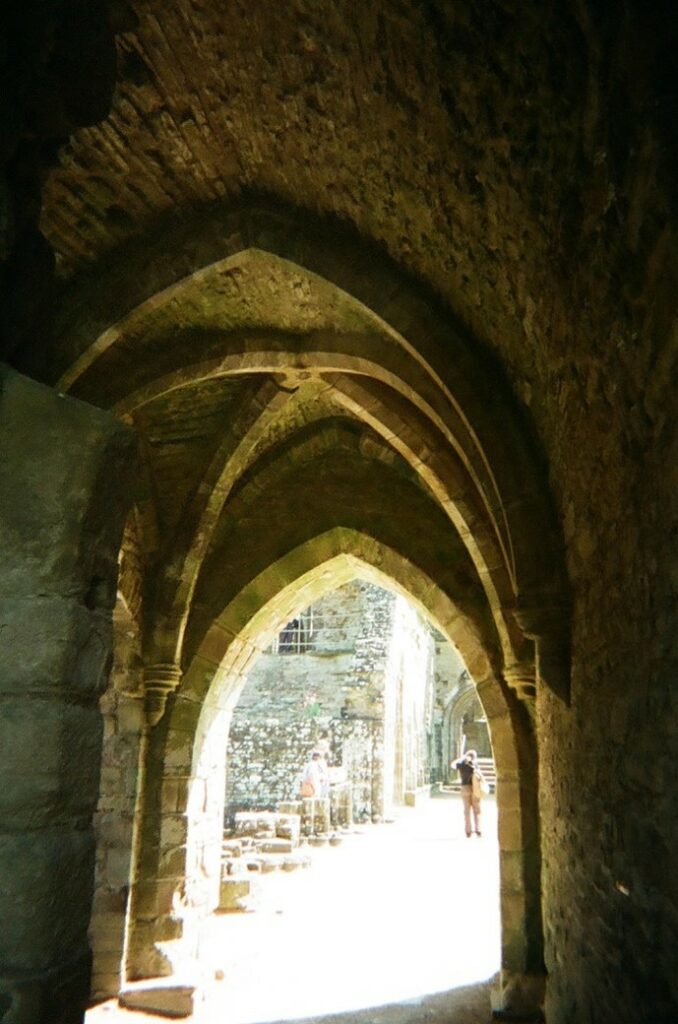Have Stories, Will Travel

This week, Kara and I will be in Boulder, Colorado. It’s my first real trip away from the farm since the New England travels over a year ago in October, with all the leaves ablaze. This time, Kara will be immersing in an artisan cheese-making intensive and visiting a wild donkey training ranch, while I’m exploring yarn shops, the music scene, and even taking a pottery class! I’m sure there will be stories to share about those adventures upon my return!
In the meantime, to shake off the winter blues, here is a story from an earlier travel experience—to England’s Tintern Abbey. During this month’s Writer’s Circle Workshops (co-hosted with John Adler), the remembrance of this event doubled back to mind, so I endeavored to capture on paper this adventure of nearly 10 years ago. A Travel Study through St. Olaf College landed right between my undergraduate and graduate studies, and this was one of the stops along the 17-day trip.
Tintern Abbey
I’d never been overseas before, never been away from home so long without another family member with me before. It was all new—all of it. The food, the lodging, the accents, the currency, the social customs. It was like walking into one of my books—the 15th Century hotel, Tudor style, with floors that talked to you as you stepped and ceilings that dipped like propped canopies of plaster, weary but holding in their aged state.
Another bus ride—this had become the new normal. Placid hills driving steep like the Driftless woodlands, the bus turning sharp corners as we descended, waving off our side of the yellow lines. Pines poking up, obscuring the riverbed below, then flattening out just as our point of arrival came into view. This was also the new normal—hidden nooks with a hundred past lives, only found when you were almost upon them.
Tintern Abbey. For many, this was a Wordsworth stop, even though he’d actually written his musing poem seven miles up the river. But here were the ruins, and we were released into them like rats escaping from a ship onto the harbor—no guided tour, no prescribed syllabus for the experience.
I’d worked purposely not to over-study the trip. I knew that I could always do more research at home. So I approached open, ready for the experience, seeking only to soak in that which was around me. I might never be in this spot again during this lifetime.
I wrote in my journal that night about how the ruins reminded me of those of the Anasazi in Arizona, rugged, wind-worn, abandoned and left to slowly crumble with time. But here, the crumbling was not so much a mystery. 400 years of Benedictine care had built these walls, the hospital, the chapel…then one greedy king proclaimed a dissolution 500 years ago.
Bases of pillars, walls with no windows. Ceilings with only the movements of clouds to block the sunlight from below. A hushed stillness blanketed the space—we all spoke in quieted tones, even though no sign mandated such reverence.
Doves and pigeons perched on the graying stones above, eyeing us intently—feathered spirits of those gone before, still watching over their place of dedication. Even if nothing could be done to restore the former grandeur, still they could keep their watchful vigil above the straggling mix of strangers below.
Much of what was left of the compound stood only a foot or two high—pillaged by needy locals in search of materials for homes and walls and roads. Common materials moving on to another, still common purpose. No sense in wasting it, just like farmers back home reusing wire and doors and windows and boards until they were long past their prime.
Here, archways stood in defiance, showing their Gothic peaks in the golden sandstone, marred over by falling carbon from skies that had witnessed the dawn of the Industrial Revolution. But not the chapel. Here, though one wing had fallen, the rest was starkly intact—as if the roof and windows and doors had but recently been removed.
The air distinctly changed as I entered the chapel—cooler, still, impressed with solemn dignity. Having walked through Salisbury Cathedral just a few days before, I could easily paint upon the scene what this would have been in its prime. The pillars even had the same layering of large and small cylinders, reaching to the sky, the windows opening in the classic outlines, as if pressed from the same cookie cutter into gingerbread walls of crumbling stone.
(Story continued next week).






